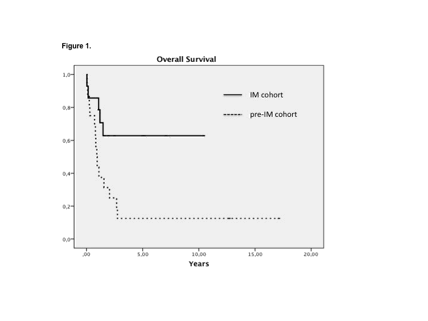Abstract
Philadelphia positive acute lymphoblastic leukemia (Ph + ALL) accounts for approximately 20% -30% of all adult ALL. The prognosis of patients with Phi + ALL is unfavorable when treated with standard chemotherapy schemes, presenting a long-term survival of 15% -20%. Since the introduction of Imatinib (IM) to treatment regimens the survival of these patients has improved, although allogeneic hematopoietic stem cell transplantation (HSCT) remains the only curative option. We conducted a retrospective analysis of Ph + ALL patients before and after IM became available in order to analyze the impact of IM on survival in adult Phi + ALL.
Patients and methods
Between April 1997 and April 2013 we diagnosed 120 over 15 year old patients with ALL (B and T lineage), 31 (25.8%) of which were Phi +, all B lineage. Of these 31 cases, 30 were treated with protocols from Spanish group PETHEMA with curative intent. 14 of them (47%) were treated with chemotherapy and Imatinib (IM cohort) and 16 (53%) with chemotherapy (pre-IM cohort). In 17 of the 30 cases allogeneic HSCT was performed, 7 in the pre-IM cohort and 10 in the IM cohort. In the post-transplant period, two patients were treated with Dasatinib due to positive minimal residual disease (BCR-ABL1 positive). The probabilities of overall survival (OS) (death) and event free survival (EFS) (no response, relapse or death) were estimated using the Kaplan-Meier product limit method. Differences between groups were tested using the X2 test. Univariate analysis was performed using Cox regression models or log-rank test. Multivariate analysis was performed using Cox proportional hazards regression model. The study was conducted in accordance with the Declaration of Helsinki.
Results
The median age was 38 years (range, 15-66 years), 17 patients were males and 13 females. The whole series survival was 32.4 ± 9.2%. The OS mean of the pre-IM cohort was 3.1 years (CI 95%, 0.5-5.7) and 6.9 years (CI 95%, 4.4-9.4) in the IM cohort (figure 1). The main characteristics of both groups are reflected in Table 1.
When we analyzed the EFS, the variables that influenced it were being treated with IM (48% in the IM cohort versus 12.5% in the pre-IM cohort, p = 0.03), having received an allogeneic HSCT (45% versus 8%, p = 0.004) and being in first complete remission before allogeneic HSCT (51% versus 0%, p <0.001).
In the analysis of OS, the only variables with prognostic significance were: treatment with IM (63% in the IM cohort versus 12.5% in the pre-IM cohort, p = 0.01) and having received an allogeneic HSCT (55 % versus 0%, p <0.001). When the 17 patients that received allogeneic HSCT were analyzed separately, OS in the pre-IM cohort was 29 ± 17% versus 79 ± 13% in the IM cohort (p = 0.057).
Patient characteristics (N=30)
| Characteristic . | Pre-IM cohort (N=16) . | IM cohort (N=14) . | P . |
|---|---|---|---|
| Female/Male | 7/9 | 6/8 | 0.96 |
| Age ² 40 years | 12 (75%) | 10 (71%) | 0.82 |
| ³ 50 x109/L WBC | 8 (50%) | 4 (29%) | 0.23 |
| Transcript type: e1a2 b2a2/b3a2 | 12 (75%) 4 (25%) | 11 (79%) 3 (21) | 0.83 |
| Morphological CR after induction | 13/15 (88%) | 13/13 (100%) | 0.17 |
| No. of Allo-HSCT | 7 (44%) | 10 (71%) | 0.13 |
| CR pre Allo-HSCT: 1CR 2CR | 5 (71%) 2 (29%) | 10 (100%) 0 (0%) | 0.07 |
| Relapse | 8/13 (61.5%) | 4/13 (31%) | 0.12 |
| Exitus | 14 (87.5%) | 5 (36%) | 0.003 |
| Characteristic . | Pre-IM cohort (N=16) . | IM cohort (N=14) . | P . |
|---|---|---|---|
| Female/Male | 7/9 | 6/8 | 0.96 |
| Age ² 40 years | 12 (75%) | 10 (71%) | 0.82 |
| ³ 50 x109/L WBC | 8 (50%) | 4 (29%) | 0.23 |
| Transcript type: e1a2 b2a2/b3a2 | 12 (75%) 4 (25%) | 11 (79%) 3 (21) | 0.83 |
| Morphological CR after induction | 13/15 (88%) | 13/13 (100%) | 0.17 |
| No. of Allo-HSCT | 7 (44%) | 10 (71%) | 0.13 |
| CR pre Allo-HSCT: 1CR 2CR | 5 (71%) 2 (29%) | 10 (100%) 0 (0%) | 0.07 |
| Relapse | 8/13 (61.5%) | 4/13 (31%) | 0.12 |
| Exitus | 14 (87.5%) | 5 (36%) | 0.003 |
Abbreviations: IM, imatinib. WBC, white blood cells. CR, complete remision. Allo-HSCT, allogenetic hematopoietic stem cell transplantation.
Conclusions
In our study we show how adult Phi + ALL patients who are treated with chemotherapy associated with IM and subsequently receive an allogeneic HSCT exhibit a higher overall survival rate than those treated in the pre-IM era. Although Phi + ALL is still considered of very high risk, in our series of patients treated in the IM era, with a follow-up of over 7 years, overall survival was of 63%, higher than that of historical series of adults with Phi negative ALL.
This work has been financed by a grant from the Malaga Association for Research in Leukemia "AMPILE" and the FIS 11-01966 project.
No relevant conflicts of interest to declare.
Author notes
Asterisk with author names denotes non-ASH members.


This feature is available to Subscribers Only
Sign In or Create an Account Close Modal